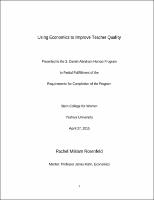Please use this identifier to cite or link to this item:
https://hdl.handle.net/20.500.12202/4195| Title: | Using Economics to Improve Teacher Quality |
| Authors: | Rosenfeld, Rachel Miriam |
| Keywords: | Educational accountability --United States. Effective teaching --United States. Teachers --Salaries, etc. --United States. Educational statistics. Teachers --Rating of --United States. Teaching --United States --Economic policy. |
| Issue Date: | Apr-2015 |
| Publisher: | Stern College for Women |
| Abstract: | Most researchers agree that teacher quality is one of the most important factors in determining educational success, and it is one of the few powerful factors that may be directly influenced by public policy (“Pay, Working Conditions” 70; Chetty, Friedman, and Rockoff 6; Navon and Shavit 304). As economist Caroline Hoxby points out, the implications of quality education in the US extend much farther than the classroom. The American economy’s strength is in its relative abundance of educated workers, and maintaining a good education system is important to the economy as a whole (“School Choice and School Productivity” 293). It is in everyone’s best interest to determine how teacher quality can be assessed, maintained, and systematically encouraged. However, this task is no small feat; it is difficult to identify quality teachers by any directly measurable characteristic, and even once identified, a system needs to be in place to foster good teachers. The two primary challenges to improving teaching are assessing quality and setting incentives for educational systems to act on that assessment. Since teacher quality is difficult to pin down, the most accurate way to identify quality teaching is retrospectively, using the value-added method after a teacher’s first few years at work. Although the value-added method addresses one challenge to improving teaching, more is necessary to create an efficacious educational system. To ensure schools are motivated to retain their best teachers and let go of the least effective, some level of competition should be maintained within school districts. Federal and state governments should also consider offering additional funding to schools that reach threshold achievement levels, encouraging schools to maintain a quality faculty and improve the level of education. |
| Description: | The file is restricted for YU community access only. |
| URI: | https://hdl.handle.net/20.500.12202/4195 https://ezproxy.yu.edu/login?url=https://repository.yu.edu/handle/20.500.12202/4195 |
| Appears in Collections: | S. Daniel Abraham Honors Student Theses |
Files in This Item:
| File | Description | Size | Format | |
|---|---|---|---|---|
| Rachel-Rosenfeld.pdf Restricted Access | 215.57 kB | Adobe PDF |  View/Open |
This item is licensed under a Creative Commons License

